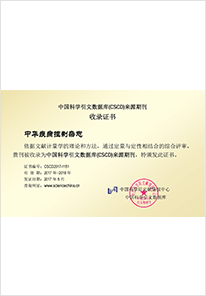2020 Vol. 24, No. 6
Display Method:
2020, 24(6): 621-627.
doi: 10.16462/j.cnki.zhjbkz.2020.06.002
Abstract:
2020, 24(6): 632-637.
doi: 10.16462/j.cnki.zhjbkz.2020.06.003
Abstract:
2020, 24(6): 638-642.
doi: 10.16462/j.cnki.zhjbkz.2020.06.004
Abstract:
2020, 24(6): 643-648.
doi: 10.16462/j.cnki.zhjbkz.2020.06.005
Abstract:
2020, 24(6): 649-654.
doi: 10.16462/j.cnki.zhjbkz.2020.06.006
Abstract:
2020, 24(6): 655-659.
doi: 10.16462/j.cnki.zhjbkz.2020.06.007
Abstract:
2020, 24(6): 660-664.
doi: 10.16462/j.cnki.zhjbkz.2020.06.008
Abstract:
2020, 24(6): 670-675.
doi: 10.16462/j.cnki.zhjbkz.2020.06.010
Abstract:
2020, 24(6): 676-681.
doi: 10.16462/j.cnki.zhjbkz.2020.06.011
Abstract:
2020, 24(6): 682-685.
doi: 10.16462/j.cnki.zhjbkz.2020.06.012
Abstract:
2020, 24(6): 686-690.
doi: 10.16462/j.cnki.zhjbkz.2020.06.013
Abstract:
2020, 24(6): 691-695.
doi: 10.16462/j.cnki.zhjbkz.2020.06.014
Abstract:
2020, 24(6): 696-700.
doi: 10.16462/j.cnki.zhjbkz.2020.06.015
Abstract:
2020, 24(6): 701-705.
doi: 10.16462/j.cnki.zhjbkz.2020.06.016
Abstract:
2020, 24(6): 706-710.
doi: 10.16462/j.cnki.zhjbkz.2020.06.017
Abstract:
2020, 24(6): 711-715.
doi: 10.16462/j.cnki.zhjbkz.2020.06.018
Abstract:
2020, 24(6): 716-722.
doi: 10.16462/j.cnki.zhjbkz.2020.06.019
Abstract:
2020, 24(6): 728-732.
doi: 10.16462/j.cnki.zhjbkz.2020.06.021
Abstract:
2020, 24(6): 733-736.
doi: 10.16462/j.cnki.zhjbkz.2020.06.022
Abstract:
2020, 24(6): 741-744.
doi: 10.16462/j.cnki.zhjbkz.2020.06.024
Abstract:


 Email alert
Email alert RSS
RSS Abstract
Abstract HTML
HTML PDF
PDF





